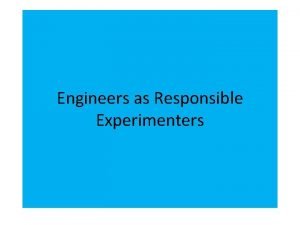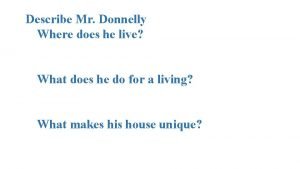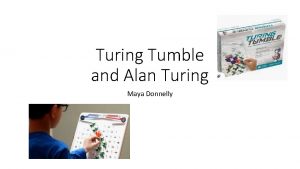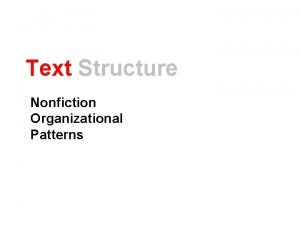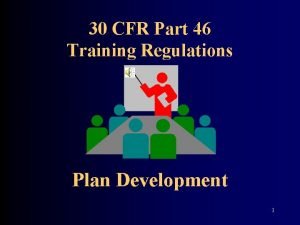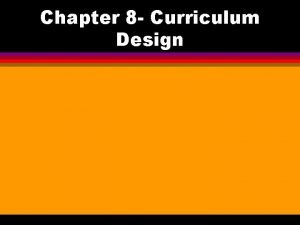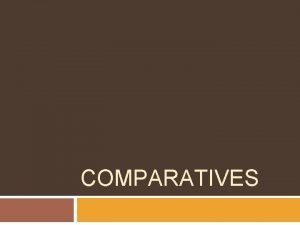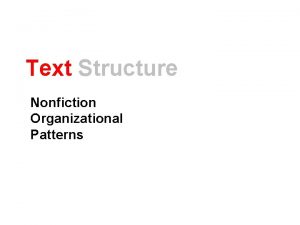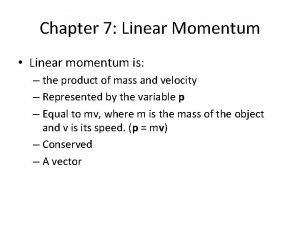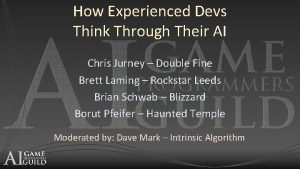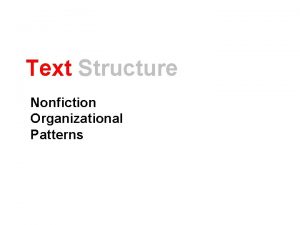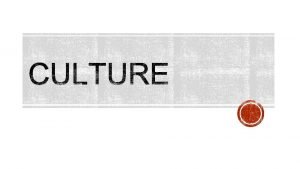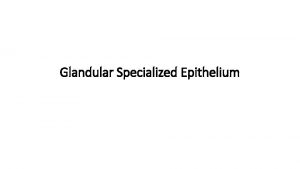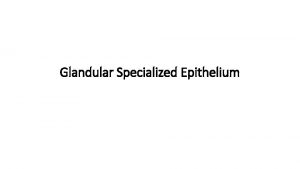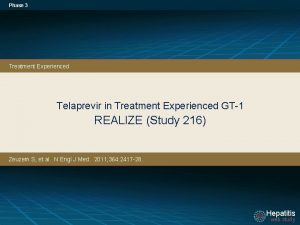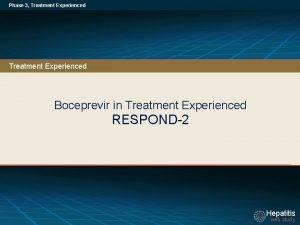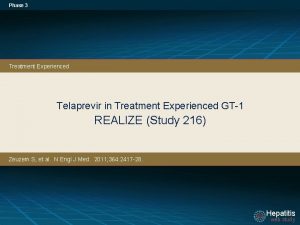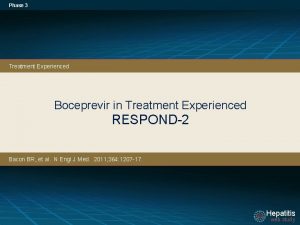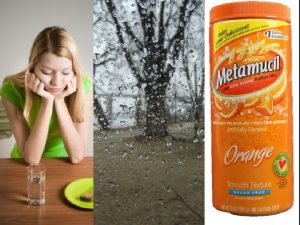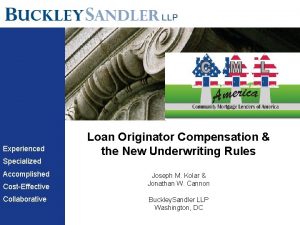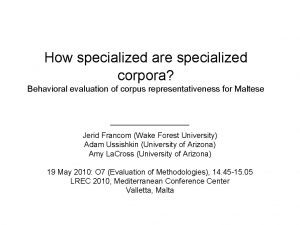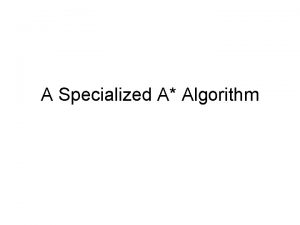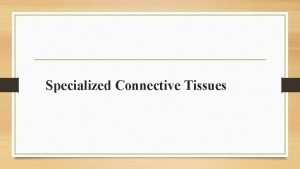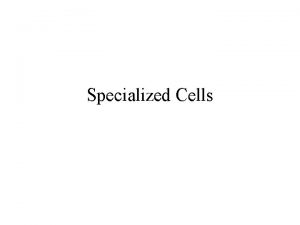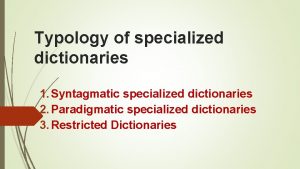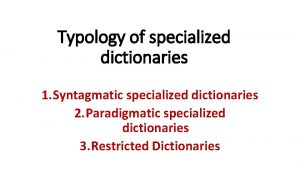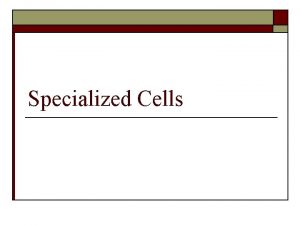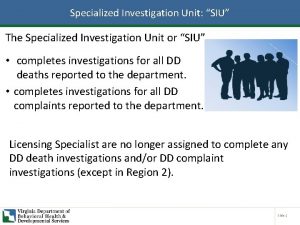Specialized Custom DOE for Experienced Experimenters Tom Donnelly









































- Slides: 41

Specialized Custom DOE for Experienced Experimenters Tom Donnelly JMP Systems Engineer Tom. Donnelly@jmp. com Copyright © SAS Inst itute Inc. All rig hts reserved.

Agenda Multiple Response Optimization – Trade-Space Analysis • Review of Classic DOE • Real-World Experimental Issues – Custom DOE is about Making • Designs Fit the Problem – NOT Making Problems Fit the Designs • Three Example Designs • Augment a broken design with constraints • Augment a screening design to RSM (sequential experimentation) • Create a design from a candidate set of trials – a good way to examine historical (haphazard) data Copyright © SAS Inst itute Inc. All rig hts reserved.

Why use DOE? Quicker answers, lower costs, solve bigger problems More rapidly answer “what if? ” questions • Do sensitivity and trade-space analysis • Optimize across multiple responses • By running efficient subsets of all possible combinations, one can – for the same resources and constraints – solve bigger • problems • By running sequences of designs one can be as cost effective as possible and run no more trials than needed to get a useful answer Copyright © SAS Inst itute Inc. All rig hts reserved.

Number of Unique Trials for 3 Response-Surface Designs and Number of Quadratic Model Terms vs. Number of Continuous Factors 36 trial I-optimal response-surface design started as 10 -factor DSD and was then augmented with 12 more trials in 6 most important factors If generally running 3, 4 or 5 -factor fractional-factorial designs… 1. How many interactions are you not investigating? 2. How many more trials needed to fit curvature? 3. Consider two stages: Definitive Screening + Augmentation Copyright © SAS Inst itute Inc. All rig hts reserved.

Real-World Design Issues How many experimenters have any of these issues? Most of these are NOT well treated by classic DOE. Work with these different kinds of control variables/factors: • • Continuous/quantitative? Finely adjustable like temperature, speed, force • Categorical/qualitative? Comes in types, like material = rubber, polycarbonate, steel with mixed # of levels; 3 chemical agents, 4 decontaminants, 8 coupon materials… • Mixture/formulation? Blend different amounts of ingredients and the process performance is dependent on the proportions more than on the amounts • Blocking? e. g. “lots” of the same raw materials, multiple “same” machines, samples get processed in “groups” – like “eight in a tray, ” run tests over multiple days – i. e. variables for which there shouldn’t be a causal effect Work with combinations of these four kinds of variables? • Certain combinations cannot be run? (too costly, unsafe, breaks the process) • Would like to add onto existing trials? (really expensive/time consuming to run) • My design broke! Repair design by augmenting with constraints. • Copyright © SAS Inst itute Inc. All rig hts reserved.

Real World Variables Copyright © SAS Inst itute Inc. All rig hts reserved.

Categorical Factors and Responses • Agent 1 • Agent 2 • Agent 3 • Decontaminants • • Decon 1 Decon 2 Decon 3 Decon 4 • Materials • • Steel Aluminum Glass Polycarbonate CARC (Paint) Viton Kapton Silicone Copyright © SAS Inst itute Inc. All rig hts reserved. Responses • • • Pass/Fail Yes/No Not Cracked/Cracked Safe/Caution/Unsafe Not Corroded/ Moderately Corroded/ Severely Corroded

Continuous Factors and Responses Factors • • • Time Temperature Amount of Agent/Unit Area Wind Speed Humidity Responses • Evaporation Rate • Absorption • Adsorption • Residual Concentration Copyright © SAS Inst itute Inc. All rig hts reserved.

Discrete Numeric Variable Example: Number of Teeth on Bicycle Sprockets 1 8 2 2 1 6 2 4 2 8 Copyright © SAS Inst itute Inc. All rig hts reserved.

Discrete Numeric Variable Only make four sizes of pizza 10”, 12”, 14” & 16” Mid-point of full range is 13” diameter. 10” 12” Corresponding areas in sq. in. are: 78, 113, 154 & 201 Mid-point of full range is 123 sq. in. or 12. 5” diameter. Could use either set of four actual sizes in diameter or area as levels of a discrete numeric variable. 14” Copyright © SAS Inst itute Inc. All rig hts reserved. 16”

Mixture Variables Simple mixture – Making salad dressing • Relative proportions of factors or components is more important than actual quantity • Three liquid components - Oil, Water, and Vinegar • 8 oz. in Cruet vs. 4 gal. in Jug 5 oz. “O” 320 oz. 1 oz. “W” 64 oz. 2 oz. “V” 128 oz. 5/8 1/4 –– O –– 100. 0% –– O –– –– W –– –– V –– 37. 5% 25. 0% –– W –– –– V –– • To study these mixture components in a DOE use ranges that are proportions: O: W: V: 0. 500 to 0. 750 0. 000 to 0. 250 0. 125 to 0. 375 (½ to ¾) (0 to ¼) (⅛ to ⅜) • Sum of proportions constrained to equal 1. 0% 1 = O + W + V so therefore… W = 1 – (O + V), O = 1 – (V + W), & V = 1 – (O + W) Copyright © SAS Inst itute Inc. All rig hts reserved.

Blocking Factor like “Day”or “Batch” • A design run over 5 days that is sensitive to humidity might SHIFT on Thursday § But what if because of the rain the tester from days 1, 2, 3 & 5 didn’t make it to work? § What if that day the power went out briefly? Or, dept. meeting “paused” the work? Or…? • The block variable doesn’t tell you the cause of the effect - just that a shift has been detected among blocks. • Hoping block variable has no effect. If it does then how can we reliably predict other blocks? If significant it probably means we are missing a factor. • The only way to be sure that no “unknown” factor has crept into the experiment, is to test for it - and “blocking” your design is not expensive. • Block variable is a categorical factor having only 1 -way effects (no interactions) Copyright © SAS Inst itute Inc. All rig hts reserved.

Time and Temperature Constraints Uncoded Create DOE for Pizza Process • Time: OVER BAKED “BURNT” 10 20 • Temp: 350 450 • Pizza Size: 10, 12, 14 & 16 • Pizza Type § Cheese § Veggies § Meats • Batch (Size = 5) UNDER BAKED • Hi + Hi = “Burnt” • Lo + Lo = “Not Done” Copyright © SAS Inst itute Inc. All rig hts reserved.

Time and Temperature Constraints Uncoded Shorter times means more product produced per hour • Make most of our money in a few hours each evening • MAKE MORE $$$ MAKE LESS $ Copyright © SAS Inst itute Inc. All rig hts reserved.

Time and Temperature Constraints Coded vs. Uncoded Copyright © SAS Inst itute Inc. All rig hts reserved.

Time and Temperature Constraints Coded Copyright © SAS Inst itute Inc. All rig hts reserved.

Time and Temperature Constraints Coded y = mx + b • Temp = m*Time + b • [1]*Temp = [-1]*Time + [1] • [1]*Time + [1]*Temp = [1] • • [1]*Time + [1]*Temp <= [1] y = mx + b • Temp = m*Time + b • [1]*Temp = [-1]*Time + [-1] • [1]*Time + [1]*Temp = [-1] • • [1]*Time + [1]*Temp >= [-1] Copyright © SAS Inst itute Inc. All rig hts reserved.

Time and Temperature Constraints Uncoded Copyright © SAS Inst itute Inc. All rig hts reserved.

Time and Temperature Constraints Uncoded Copyright © SAS Inst itute Inc. All rig hts reserved.

Time and Temperature Constraints Uncoded y = mx + b • Temp = m*Time + b • [1]*Temp = [-10]*Time + [600] • [10]*Time + [1]*Temp = [600] • • [10]*Time + [1]*Temp <= [600] • y = mx + b • Temp = m*Time + b • [1]*Temp = [-10]*Time + [500] • [10]*Time + [1]*Temp = [500] • [10]*Time + [1]*Temp >= [500] Copyright © SAS Inst itute Inc. All rig hts reserved.

Time and Temperature Constraints Uncoded Copyright © SAS Inst itute Inc. All rig hts reserved.

Final Design Showing Constrained Regions Copyright © SAS Inst itute Inc. All rig hts reserved.

Final Design Showing Constrained Regions Copyright © SAS Inst itute Inc. All rig hts reserved.

Definitive Screening Case Study Copyright © SAS Inst itute Inc. All rig hts reserved.

Original design was for 11 variables with 23 unique trials and the center point replicated once. Copyright © SAS Inst itute Inc. All rig hts reserved.

Analysis Strategies • Visual Tools: § Distribution – click on “good” and “bad” response values to see correlations with factor settings § Graph Builder – Y vs. X graphs – all data, summarized data, fit line, smoother » Drop factors side by side or alternatively (for coded factors) stack factors then replot » Use Overlay field to look at possible interactions between two factors • Analytic Tools: § Conservative: Main Effects fit – look at Scaled estimates » Consider adding interactions among significant factors using Effects Heredity and Sparsity § Aggressive: Strepwise with various stopping criteria » AICc, BIC, K-fold, Excluded checkpoints, » Fit All Possible Models § Analytic Output: » Stepwise Histories – Criterion or Rsquare » Actual vs. Predicted with Graph Builder – Col Switch different models » Create All Possible Models Table – Plot four metrics using Overlap Plot Copyright © SAS Inst itute Inc. All rig hts reserved.

All Analyses Rank Factors A, B & C as Top 3 Factor F appears to be most likely fourth factor • • Linear terms only – fourth factor is F Linear + Squared terms – fourth factor is D Stepwise with min AICc stopping rule – fourth factor is F Stepwise with max K-Fold R-Square stopping rule – fourth factor is F Stepwise with max Validation R-Square as stopping rule – fourth factor is F Generalized regression with min AICc stopping rule – fourth factor is F All possible models – fourth factor is G When D & F are in same 5 -factor (with A, B, & C) stepwise model, D drops out • When G & F are in same 5 -factor (with A, B, & C) stepwise model, G drops out • When D & G are in same 5 -factor (with A, B, & C) stepwise model, both drop out • • There is an important difference between saying, “Factor F has no effect. ” and, “Given the • Augmenting design to support 6 -factor quadratic model in A, B, C, D, F & G will amount of data taken an effect for factor F was not detected. ” § help resolve the relative contributions of D, F & G § increase the power for all – but especially - the squared terms Copyright © SAS Inst itute Inc. All rig hts reserved.

If more than a few factors are significant, then augment design to support 2 nd order model NOTE: First 13 rows of original design are not shown. These 12 trials added onto original 24 trials to support full quadratic model in 6 most important factors plus a block effect between original and augmented trials Copyright © SAS Inst itute Inc. All rig hts reserved.

Power for squared terms in 2 nd order model is increased to near that of 6 -factor RSM designs Copyright © SAS Inst itute Inc. All rig hts reserved.

Compare Augmented Designs Top: 10 -factor fractional Factorial + C. P. augmented to support full quadratic model in 6 factors 33 + 9 = 42 total trials Upper Middle: 10 -factor Placket-Burman + C. P. augmented to support full quadratic model in 6 factors 25 + 11 = 36 total trials Lower Middle: 10 -factor definitive screening augmented to support full quadratic model in 6 factors 21 + 15 = 36 total trials Bottom: 6 -factor custom DOE for full RSM model 34 total trials Copyright © SAS Inst itute Inc. All rig hts reserved.

Compare Augmented Designs Top: 14 -factor fractional Factorial + C. P. augmented to support full quadratic model in 7 factors 33 + 13 = 46 total trials Middle: 14 -factor definitive screening augmented to Support full quadratic model in 7 factors 29 + 17 = 46 total trials Bottom: 7 -factor custom DOE for full RSM model 42 total trials Copyright © SAS Inst itute Inc. All rig hts reserved.

Number of Unique Trials for 3 Response-Surface Designs and Number of Quadratic Model Terms vs. Number of Continuous Factors Unique Trials in Central Composite Design Unique Trials in Box-Behnken Design Unique Trials in Custom Design with 6 df for Model Error Terms in Quadratic Model 36 trial I-optimal response-surface design started as 10 -factor DSD and was then augmented with 12 more trials in 6 most important factors If generally running 3, 4 or 5 -factor fractional-factorial designs… 1. How many interactions are you not investigating? 2. How many more trials needed to fit curvature? 3. Consider two stages: Definitive Screening + Augmentation Copyright © SAS Inst itute Inc. All rig hts reserved.

Use JMP Trade-off and Optimization Copyright © SAS Inst itute Inc. All rig hts reserved.

Classic Response-Surface DOE in a Nutshell Block 1 Block 2 Block 3 x x x 3 3 3 Lack-of-fit x 1 Can fit data from blocks 1, 2 or 3 x 2 x 2 Lack-of-fit x 1 Fit requires data from blocks 1 & 2 Copyright © SAS Inst itute Inc. All rig hts reserved. x 1 Fit requires data from all 3 blocks

Polynomial Models Used to Calculate Surfaces Block 1 Block 2 Block 3 x x x 3 3 3 x 1 y = a 0 + a 1 x 1 + a 2 x 2 + a 3 x 3 Run this block 1 st to: (i) estimate the main effects* (ii) use center point to check for curvature. x 2 x 2 x 1 y = a 0 + a 1 x 1 + a 2 x 2 + a 3 x 3 + a 12 x 1 x 2 + a 13 x 1 x 3 + a 23 x 2 x 3 Run this block 2 nd to: (i) repeat main effects estimate, (ii) check if process has shifted (iii) add interaction effects to model if needed. Copyright © SAS Inst itute Inc. All rig hts reserved. + a 11 x 12 + a 22 x 22 + a 33 x 32 Run this block 3 rd to: (i) repeat main effects estimate, (ii) check if process has shifted (iii) add curvature effects to model if needed.

Number of Unique Trials for 3 Response-Surface Designs and Number of Quadratic Model Terms vs. Number of Continuous Factors Unique Trials in Central Composite Design Unique Trials in Box-Behnken Design Unique Trials in Custom Design with 6 df for Model Error Terms in Quadratic Model If generally running 3, 4 or 5 -factor fractional-factorial designs… 1. How many interactions are you not investigating? 2. How many more trials needed to fit curvature? 3. Consider two stages: Definitive Screening + Augmentation Copyright © SAS Inst itute Inc. All rig hts reserved.

Classic Definition of DOE Purposeful control of the inputs (factors) in such a way as to deduce their relationships (if any) with the output (responses). Copyright © SAS Inst itute Inc. All rig hts reserved.

Alternative Definition of DOE A DOE is the specific collection of trials run to support a proposed model. § If proposed model is simple, e. g. just main effects or 1 st order effects (x 1 , x 2 , x 3, etc. ), the design is called a screening DOE » Goals include rank factor importance or find a “winner” quickly » Used with many (> 6? ) factors at start of process characterization § If the proposed model is more complex, e. g. the model is 2 nd order so that it includes two-way interaction terms (x 1 x 2 , x 1 x 3, x 2 x 3, etc. ) and in the case of continuous factors, squared terms (x 12, x 22, x 32 , etc. ), the design is called a response-surface DOE » Goal is generally to develop a predictive model of the process » Used with a few (< 6? ) factors after a screening DOE Copyright © SAS Inst itute Inc. All rig hts reserved.

Quadratic Model not that Much Bigger than Interaction Model Lack-of-fit Can fit data from blocks 1, 21 stor. Order 3 Fit requires data from blocks 1 & 22 nd Order Fit requires data from all 3 nd Order 2 blocks y = a 0 + a 1 x 1 + a 2 x 2 + a 3 x 3 + a 12 x 1 x 2 + a 13 x 1 x 3 + a 23 x 2 x 3 For k factors there are k main effects For 3 factors Linear Model has 4 terms For 6 factors Linear Model has 7 terms For 10 factors Linear Model has 11 terms For k factors there are k(k-1)/2 interaction effects For 3 factors Interaction Model has 7 terms For 6 factors Interaction Model has 22 terms For 10 factors Interaction has Copyright © SAS Inst itute Inc. All rig. Model hts reserved. + a 11 x 12 + a 22 x 22 + a 33 x 32 For k factors there are k squared effects For 3 factors Quadratic Model has 10 terms For 6 factors Quadratic Model has 28 terms For 10 factors Quadratic Model has 66

Use JMP Re-make the DOE for this analysis Copyright © SAS Inst itute Inc. All rig hts reserved.

Visualize Design Balance Copyright © SAS Inst itute Inc. All rig hts reserved.
 Engineers as responsible experimenters
Engineers as responsible experimenters Judge donnelly cook county
Judge donnelly cook county Alexis donnelly
Alexis donnelly Oscar donnelly
Oscar donnelly What is unique about mr. donnelly's house?
What is unique about mr. donnelly's house? Turing tumble educator guide
Turing tumble educator guide Tom tom go 910
Tom tom go 910 Symbolism in the devil and tom walker
Symbolism in the devil and tom walker More sports at ericson genre
More sports at ericson genre Cite one example in your school or community
Cite one example in your school or community Newly hired experienced miner training
Newly hired experienced miner training Subject centered design curricular emphasis
Subject centered design curricular emphasis Experienced comparative and superlative
Experienced comparative and superlative Dimensional analysis and its applications
Dimensional analysis and its applications Devers experienced the highlight
Devers experienced the highlight Calculate the impulse experienced when a 70kg person
Calculate the impulse experienced when a 70kg person Allows rapid entry of text by experienced users
Allows rapid entry of text by experienced users Brett laming
Brett laming Devers experienced the highlight
Devers experienced the highlight Chapter 24 trauma overview
Chapter 24 trauma overview Have you ever experienced culture shock?
Have you ever experienced culture shock? Bästa kameran för astrofoto
Bästa kameran för astrofoto Tillitsbaserad ledning
Tillitsbaserad ledning Vem räknas som jude
Vem räknas som jude Ro i rom pax
Ro i rom pax Lyrik
Lyrik Nyckelkompetenser för livslångt lärande
Nyckelkompetenser för livslångt lärande Datumr
Datumr Varför kallas perioden 1918-1939 för mellankrigstiden?
Varför kallas perioden 1918-1939 för mellankrigstiden? Borstål, egenskaper
Borstål, egenskaper Vishnuiter
Vishnuiter Bamse för de yngsta
Bamse för de yngsta Verktyg för automatisering av utbetalningar
Verktyg för automatisering av utbetalningar Aktiv exspektans
Aktiv exspektans Jag har nigit för nymånens skära
Jag har nigit för nymånens skära Sura för anatom
Sura för anatom Stig kerman
Stig kerman Strategi för svensk viltförvaltning
Strategi för svensk viltförvaltning Novell typiska drag
Novell typiska drag Informationskartläggning
Informationskartläggning Tack för att ni har lyssnat
Tack för att ni har lyssnat Klassificeringsstruktur för kommunala verksamheter
Klassificeringsstruktur för kommunala verksamheter
